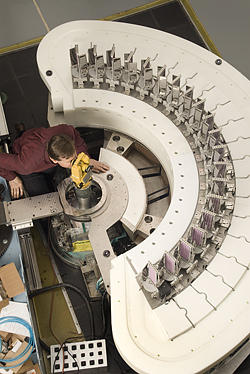
Top view of the MACS multiaxis detector system (seen before being enclosed in shielding material). With more neutrons striking the sample and more detectors surrounding it, MACS will greatly extend the capabilities of neutron inelastic scattering as a materials probe technique in nanotechnology and basic science. Principal investigator Collin Broholm of the Johns Hopkins University is seen examining the alignment of one of the 20 detection channels.
Researchers at the National Institute of Standards and Technology (NIST) and The Johns Hopkins University have constructed a unique tool for exploring the properties of promising new materials with unprecedented sensitivity and speed—potentially allowing them to identify quickly those most useful for nanotechnology and industrial applications.
This novel instrument, called the Multi-Axis Crystal Spectrometer (MACS), is a variation on several other spectrometers at the NIST Center for Neutron Research (NCNR), where MACS is located. Like them, MACS bombards a sample of material with low-energy neutrons, which then bounce off the sample's constituent atoms in specific directions and with specific velocities that reflect the arrangement of atoms within the material. Analyzing how neutrons scatter from a sample can tell scientists a great deal about the material's physical properties, but older spectrometers are limited to relatively large samples and offer less range in the conditions under which they can be tested.
"These limitations are problematic in nanotechnology," says Professor Collin Broholm of the Johns Hopkins University, "because oftentimes you grow a new material as a tiny crystal weighing only four or five milligrams, and then you want to see how it behaves under, say, an intense magnetic field."
Not only can MACS overcome these limitations, but its unique construction allow has additional advantages. Many spectrometers provide just a single "channel" for detection, whereas MACS offers 20, forming a semicircle behind the sample—an arrangement that leads Broholm to compare MACS to a wide-angle, high-resolution lens. These improvements mean that MACS could become a favorite tool for scientists who must choose—and choose quickly—what material to grow next.
"With previous instruments for inelastic scattering from magnetic materials, 80 milligrams is about the smallest sample you can work with," Broholm says. "But with MACS, we might be able to get detailed information about magnetic interactions even from a nano-structured thin film sample. These are the sort of interactions that nanotechnologists are trying to take advantage of when they design and shape things at the nanoscale."
Broholm's team is still fine-tuning MACS and expects to issue a full call for proposals to use the new spectrometer in about six months. Additional information on the NIST Center for Neutron Research http://www.ncnr.nist.gov/, a national user facility, is available on the facility's Web site, including a list of available instruments at http://www.ncnr.nist.gov/instruments/. MACS is supported by the National Science Foundation.

